Generator Safety Checklist
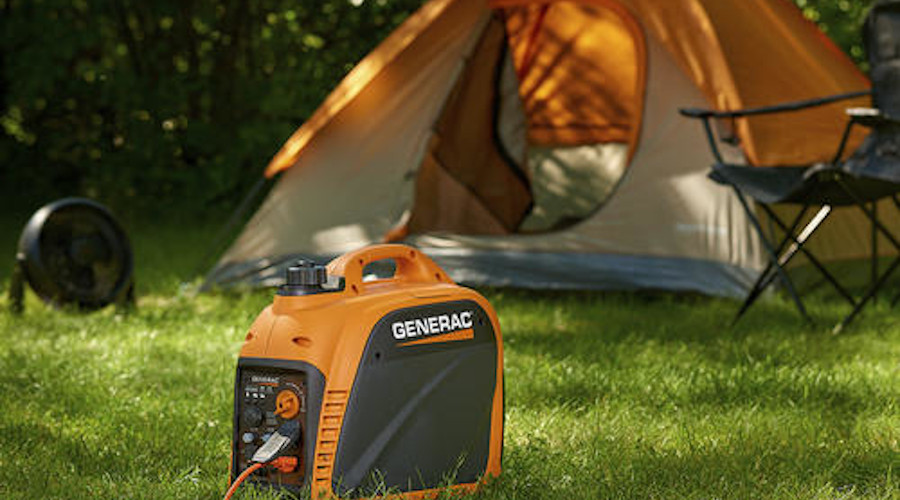
Portable Generators are versatile tools that supply electrical power wherever it’s needed and unavailable from other sources. Recreational uses include camping, tailgating, and picnics. Contractors and construction workers use them on jobsites. Homeowners extend the reach of their power tools or use them for emergency power during an outage.
As the cost of Portable Generators have declined, use and demand have risen—especially after weather related disasters such as hurricanes and tropical storms. Improvements in portability, noise reductions, and fuel efficiency bring with them a sense of ease that sometimes leads to complacency and portable generator safety is often forgotten or neglected. This becomes especially true after last-minute purchases during widespread outages during or after a disaster.
Read the Owner’s Manual
 Of all the possible portable generator tips, reading the manual seems so simple and obvious, and yet how many of us use tools with the manual still in the plastic bag it was packed in. Portable generator hazards include electrocution, severe burns, carbon monoxide poisoning, and even fire or explosions. The owner’s manual provides safety information specific to the model generator you just took out of the box.
Of all the possible portable generator tips, reading the manual seems so simple and obvious, and yet how many of us use tools with the manual still in the plastic bag it was packed in. Portable generator hazards include electrocution, severe burns, carbon monoxide poisoning, and even fire or explosions. The owner’s manual provides safety information specific to the model generator you just took out of the box.
Take five or ten minutes to read the safety information, then set up properly following the guidelines for portable generator safety.
Safe Use of Generators at Home and Away
Take it Outside
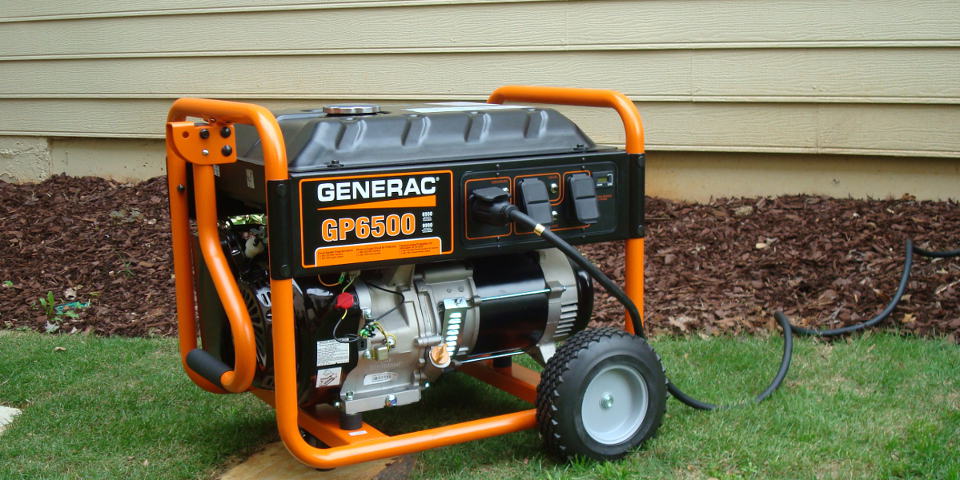 Never operate a portable generator inside a home, garage, or shed. The Consumer Product Safety Commission estimates that about 50 people die every year from carbon monoxide poisoning related to improper generator use. Portable Generator exhaust contains deadly carbon monoxide and can fill an enclosed space to lethal levels in just five minutes. The gas is odorless. Even if you don’t smell exhaust, the space can fill with CO and quickly reach toxic levels. Guide: How to Stay Safe During Power Outages
Never operate a portable generator inside a home, garage, or shed. The Consumer Product Safety Commission estimates that about 50 people die every year from carbon monoxide poisoning related to improper generator use. Portable Generator exhaust contains deadly carbon monoxide and can fill an enclosed space to lethal levels in just five minutes. The gas is odorless. Even if you don’t smell exhaust, the space can fill with CO and quickly reach toxic levels. Guide: How to Stay Safe During Power Outages
One of the most important emergency generator safety tips for portable or standby backup is a carbon monoxide detector on each level of the home and outside bedrooms for early detection and warning of carbon monoxide before it reaches toxic levels.
Top Portable Generators for Emergency Home Power
Fueling with Gasoline
 Virtually everyone knows that gasoline is a volatile liquid that can ignite a flash fire with just a small spark or the introduction of a flame. A hot surface can have the same effect. During use, some parts of a generator become hot enough to ignite gasoline vapors or spilled fuel. Any exposed fuels including the gas tank and the gas can you are holding may explode into flame causing severe burns and probably destroying the generator in the process.
Virtually everyone knows that gasoline is a volatile liquid that can ignite a flash fire with just a small spark or the introduction of a flame. A hot surface can have the same effect. During use, some parts of a generator become hot enough to ignite gasoline vapors or spilled fuel. Any exposed fuels including the gas tank and the gas can you are holding may explode into flame causing severe burns and probably destroying the generator in the process.
Although it’s tempting to keep the power on while refueling, always shut off the portable generator and allow it to cool before adding fuel.
Portable Generator Buyer Guide: What Size Generator do I Need?
Storing Gasoline
 Only store gasoline in containers approved for storage. Markings on the container must clearly indicate the container meets specifications for gasoline storage. Fill containers 95 percent full to allow room for expansion—4.75 gallons in five-gallon can. Store gasoline in a detached garage or shed away from ignitions sources. Never store gasoline in a house. Fire codes often prohibit the storage of more than 25 gallons of gasoline in a residential area.
Only store gasoline in containers approved for storage. Markings on the container must clearly indicate the container meets specifications for gasoline storage. Fill containers 95 percent full to allow room for expansion—4.75 gallons in five-gallon can. Store gasoline in a detached garage or shed away from ignitions sources. Never store gasoline in a house. Fire codes often prohibit the storage of more than 25 gallons of gasoline in a residential area.
Keep your fuel supply fresh. Fill your car’s gas tank from your portable generator gas cans, then take the cans to the gas station and refill them. Add stabilizer according to the instructions.
Portable Generator Fuel Storage
Protect from the Elements
 Portable Generators, through rugged and versatile for use in difficult conditions, are not made for operation in the pouring rain or driving snow. They can pose a significant hazard when used in wet conditions and exposing the alternator, electric, and electronic parts to rain or snow can cause permanent damage.
Portable Generators, through rugged and versatile for use in difficult conditions, are not made for operation in the pouring rain or driving snow. They can pose a significant hazard when used in wet conditions and exposing the alternator, electric, and electronic parts to rain or snow can cause permanent damage.
Set up your portable emergency generator under an open sided shelter if it’s raining or snowing or wet conditions are expected. Do not set up in an enclosed space.
Use Generators Safely for Emergency Power During Winter Outages
Electrical Shock and Electrocution
Shock and electrocution are often result by neglecting safety instructions in the generator manual, trying to backfeed a home, or working in wet conditions with damaged cords or those not rated for outdoor use.
Emergency generator safety during wet weather requires keeping cords out of puddles and standing water. Don’t operate the generator in standing water or where it may flood. Don’t stand in water while working on the generators or making connections.
FEMA Recommends a Generator for Disaster Preparedness
Placement and Operation
 Place the portable generator outdoors on a stable surface at least 15 to 20 feet from the home where it will not flood. Be aware of the prevailing wind and place it where exhaust won’t blow into your house or a neighboring house. Secure the generator against theft.
Place the portable generator outdoors on a stable surface at least 15 to 20 feet from the home where it will not flood. Be aware of the prevailing wind and place it where exhaust won’t blow into your house or a neighboring house. Secure the generator against theft.
Follow operating instructions for starting and operating the generator, including the correct sequence for making connections.
Portable Generators for Camping
Portable Generator Extension Cords
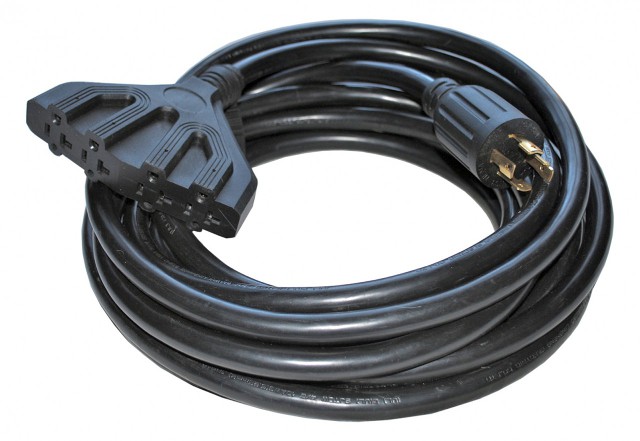 Purchase heavy duty portable generator extension cords rated for outdoor use that match or exceed the circuit breaker on the generator panel. If the generator outlet circuit breaker is rated at 15 amperes, buy a cord made to carry at least 15 amperes.
Purchase heavy duty portable generator extension cords rated for outdoor use that match or exceed the circuit breaker on the generator panel. If the generator outlet circuit breaker is rated at 15 amperes, buy a cord made to carry at least 15 amperes.
Generator manufacturers often state that it is best to plug an appliance directly into the generator. That might be possible if you’re working outdoors with power tools, but your home’s appliances won’t have cords long enough to reach outside to the generator.
How many appliances or tools do you plan to connect? Portable generator extension cords with multiple outlets can run several appliances provided the cord and the generator can handle the load.
Always use an extension cord for generator. They are rated for outdoor use and safely carry the electrical load without overheating or posing electrocution hazards.
Portable Generator Cords
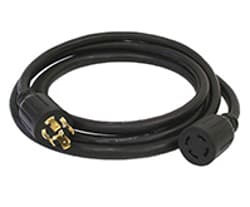 Portable generator cords plug into a 30-amp or 50-amp outlet on the generator and an inlet box on the house to supply 120 volts or 120 / 240 volts. Select portable generator cords at least 15-feet long with a plug on one end and an outlet on the other. The inlet box connects to a manual transfer switch to supply the house circuits with electricity.
Portable generator cords plug into a 30-amp or 50-amp outlet on the generator and an inlet box on the house to supply 120 volts or 120 / 240 volts. Select portable generator cords at least 15-feet long with a plug on one end and an outlet on the other. The inlet box connects to a manual transfer switch to supply the house circuits with electricity.
A portable generator cord will limit how far away you can position the generator from the house. The minimum safe distance is 15 feet from doors, windows, vents, and other openings like your garage door.
Backfeeding
An internet search will lead you to blogs and forums where self-titled experts explain how to backfeed your home by plugging the generator into an appliance outlet. They will justify the practice using numerous reasons and faulty logic.
Backfeeding is dangerous and people have died because a careless generator user connected their home this way. Current can flow out the main breaker, through the step-down transformer, and into the distribution lines at anywhere from 4000 to 50,000 volts. A downed line becomes a shock hazard for anyone nearby, including neighbors and utility workers attempting to restore power.
To backfeed a house, a homemade cord with a male plug on each end—often called a suicide cord—is required to make the connection. They are called suicide cords because if the house side of the plug becomes detached during use—say someone trips on the cord and inadvertently pulls it out—the energized plug becomes a shock and electrocution hazard.
Not only is it dangerous, but illegal in some places. Further, if you backfeed and someone is injured as a result, you are responsible for injuring or killing them and will be held liable.
XIEi9FA-0Tg
Install a Transfer Switch
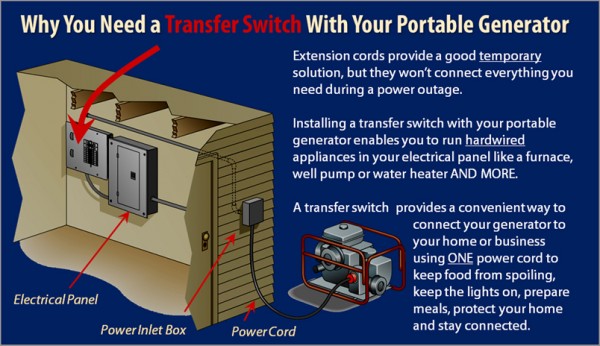 A manual transfer switch installation makes using your portable emergency generator during an outage much safer and easier. The transfer switch isolates your home from the utility lines and you won’t have to use homemade cords that pose a danger to anyone.
A manual transfer switch installation makes using your portable emergency generator during an outage much safer and easier. The transfer switch isolates your home from the utility lines and you won’t have to use homemade cords that pose a danger to anyone.
Each circuit has its own breaker. When an outage occurs, just plug the generator cord into the inlet box. Start the generator and plug the generator cord into the generator. Turn off major appliance circuits in the transfer switch, then move the transfer switch to generator. Turn the appliance circuits on one at a time, allowing a few seconds between each one.
Upgrade to a Standby Generator
 The safest way to supply electrical power to your home during a power outage. Standby generators for home use are fully automatic and eliminate many of the hazards associated with portable generators. They operate on your home’s natural gas supply or off your propane tank, so there are no volatile fuels to store and keep fresh. Moments after an outage occurs, the generator starts and runs. The Automatic Transfer Switch moves the house onto generator power while keeping the utility lines isolated.
The safest way to supply electrical power to your home during a power outage. Standby generators for home use are fully automatic and eliminate many of the hazards associated with portable generators. They operate on your home’s natural gas supply or off your propane tank, so there are no volatile fuels to store and keep fresh. Moments after an outage occurs, the generator starts and runs. The Automatic Transfer Switch moves the house onto generator power while keeping the utility lines isolated.
Sizing Guide for Home Standby Generators
Perhaps best of all, they work in any kind of weather and it won’t matter if you are at home or away on vacation. A text message or email alert will keep you informed and you can rest easy knowing your family and home are safe.
